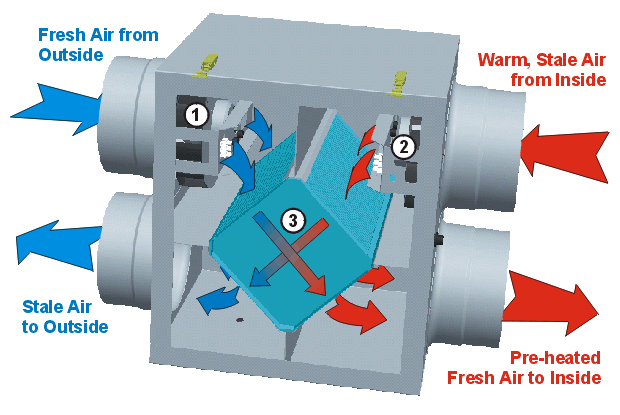Heat recovery ventilation, also known as HRV, mechanical ventilation heat recovery, or MVHR, is an energy recovery ventilation system using equipment known as a heat recovery ventilator, heat exchanger, air exchanger, or air-to-air heat exchanger which employs a cross flow or counter-flow heat exchanger (countercurrent heat exchange) between the inbound and outbound air flow.
HRV provides fresh air and improved climate control, while also saving energy by reducing heating (and cooling) requirements for many applications including vehicles.
Energy recovery ventilators (ERVs) are closely related, however ERVs also transfer the humidity level of the exhaust air to the intake air.
As building efficiency is improved with insulation and weather stripping, buildings are intentionally made more airtight, and consequently less well ventilated. Since all buildings require a source of fresh air, the need for HRVs has become obvious.
While opening a window does provide ventilation, the building’s heat and humidity will then be lost in the winter and gained in the summer, both of which are undesirable for the indoor climate and for energy efficiency, since the building’s HVAC systems must compensate. HRV introduces fresh air to a building and improves climate control, whilst promoting efficient energy use.
UK building regulations require one air change every two hours (0.5 ACH). With traditional extract-only ventilation that means your boiler has to warm up a house full of cold air 12 times a day.[3]
HRVs and ERVs can be stand-alone devices that operate independently, or they can be built-in, or added to existing HVAC systems. For a small building in which nearly every room has an exterior wall, then the HRV/ERV device can be small and provide ventilation for a single room. A larger building would require either many small units, or a large central unit.
The only requirements for the building are an air supply, either directly from an exterior wall or ducted to one, and an energy supply for air circulation, such as wind energy or electricity for fans and electronic control system. When used with ‘central’ HVAC systems, then the system would be of the ‘forced-air’ type.


